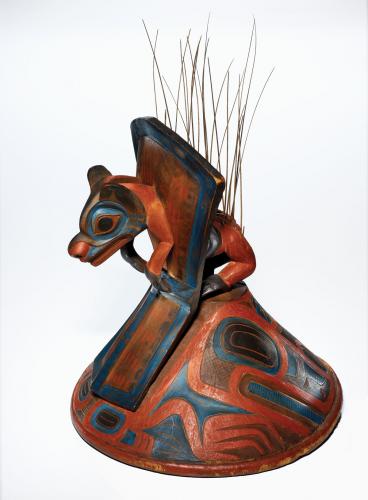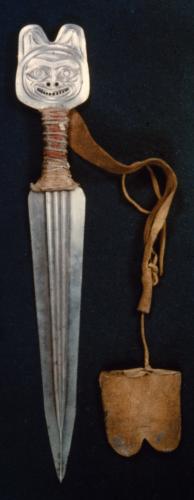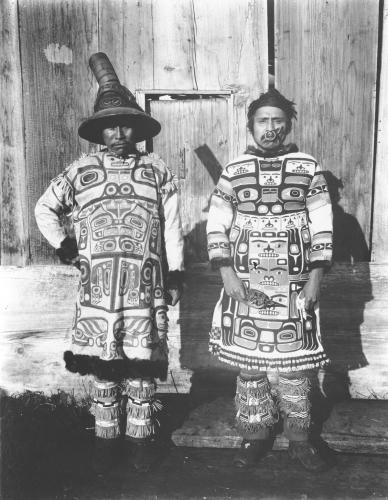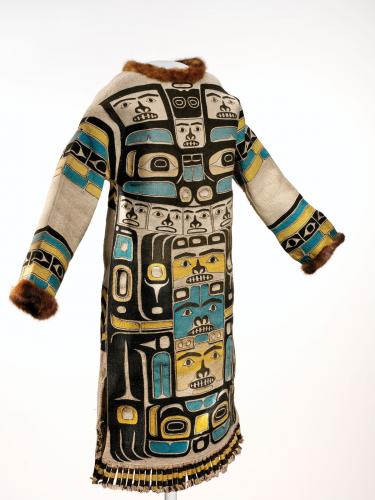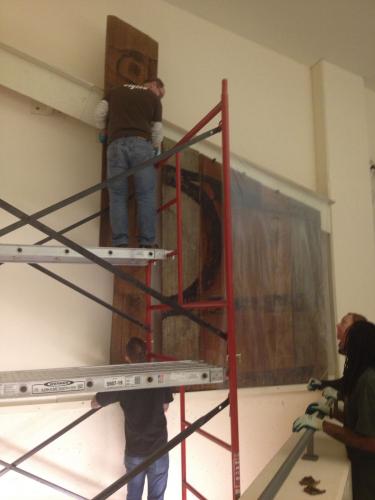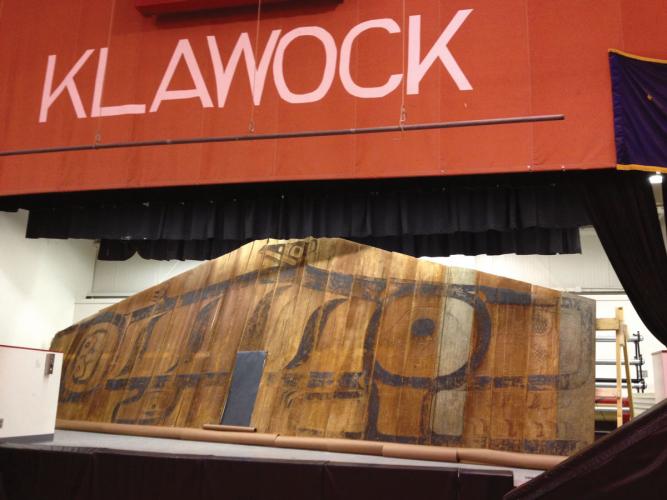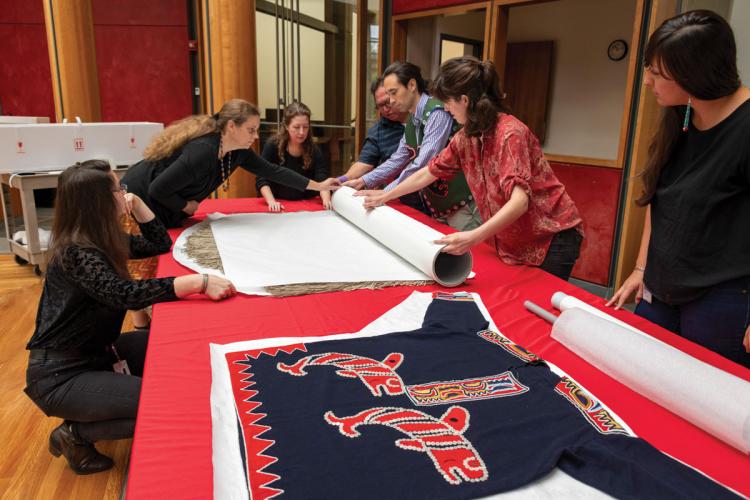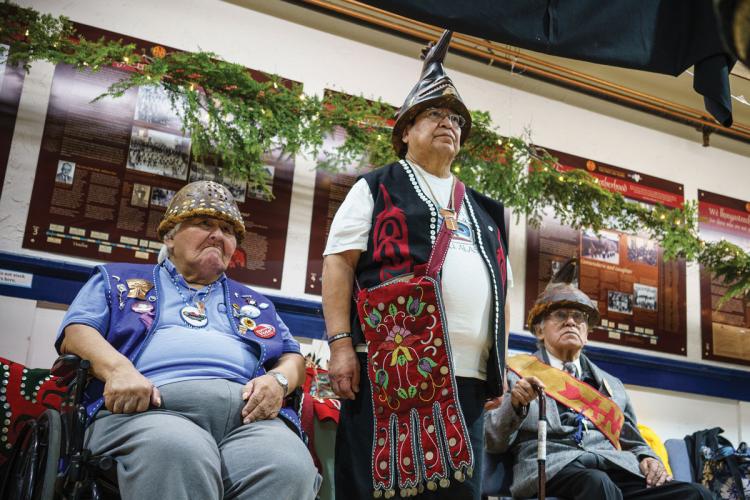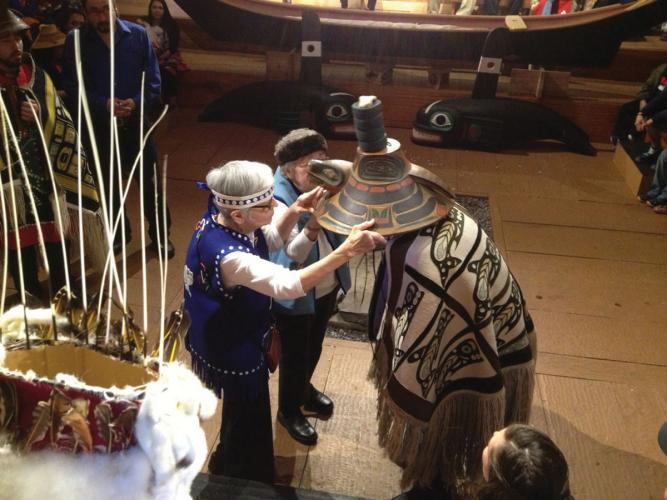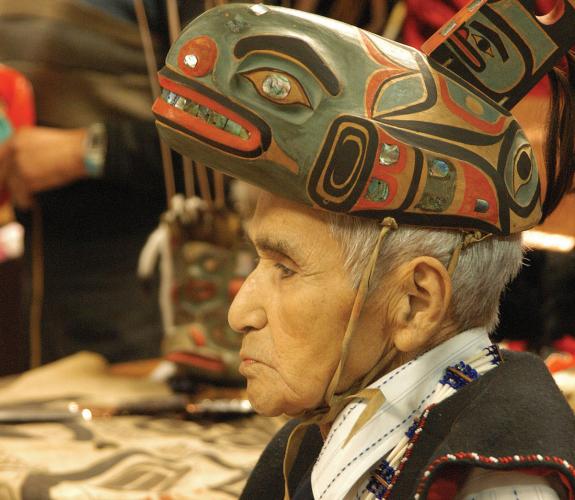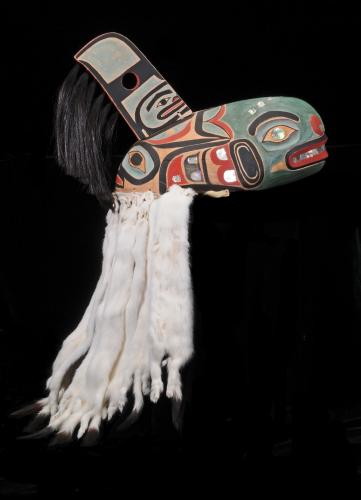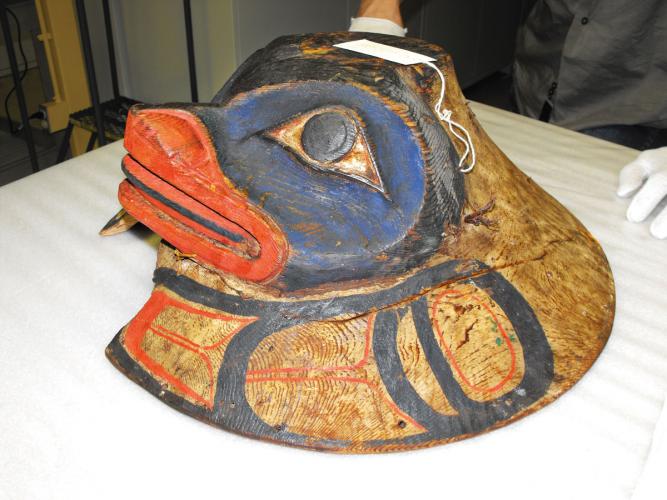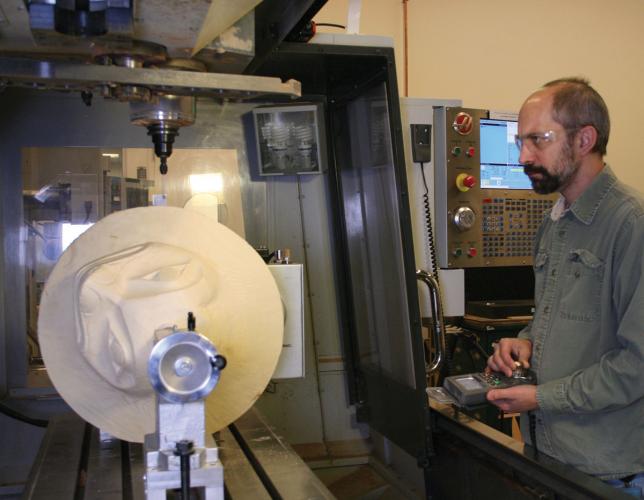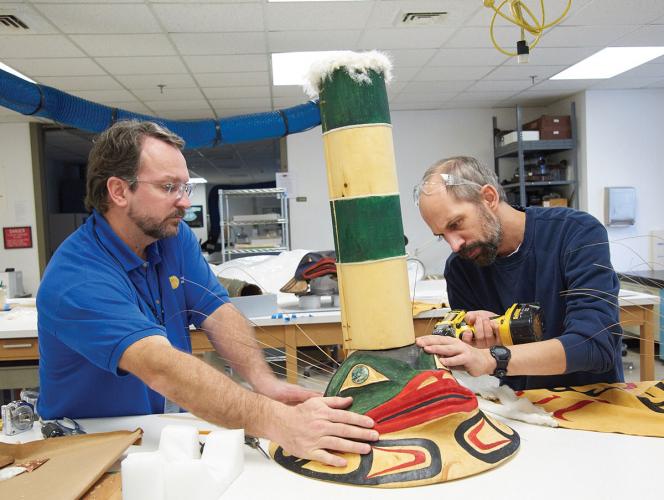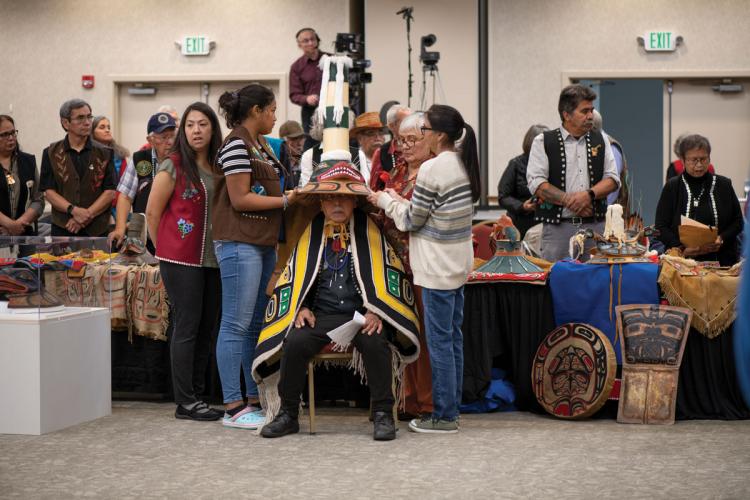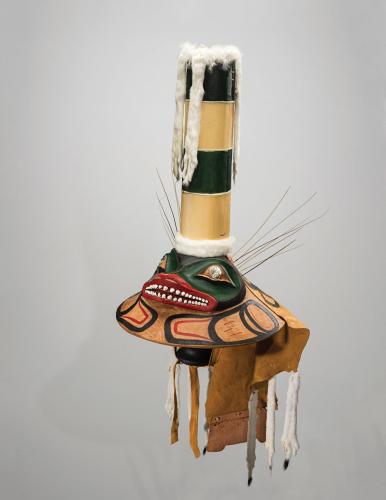For the Tlingit people of southeast Alaska, balance is everything. Although their world is divided in half—one side belonging to that of the Raven and the other to the Eagle/Wolf—those who belong to these opposite moieties are not rivals. On the contrary, they are often members of the same family by marriage. Whether in their daily lives or at ceremonies, the Tlingit (pronounced klink-kit) make sure that each side is supported and honored, often by displaying objects from their moiety that have existed for generations.
These objects are not static. They absorb the spirits of those who have used them. Harold Jacobs (Yanÿeidí), the cultural resources specialist for the Central Council Tlingit and Haida Indian Tribes of Alaska (CCTHITA, or Central Council), says, “There’s a saying the elders taught to me: ‘When these objects come out in public, the voices of all those who had them before are heard.’”
Yet during the past century or more, many of these objects were silenced. Museums and private collectors pursued them and Tlingit clans lost many objects essential to their ceremonies and other functions. “Their purpose in the Tlingit cultural world was tragically interrupted,” says Jacquetta Swift (Comanche/Fort Sill Apache), manager of repatriation at the National Museum of the American Indian.
That is why NMAI has worked diligently with Central Council to bring these culturally critical items home. From 1997 to 2015, the council had submitted requests on behalf of clans for their items to be returned to them. September 2019 marked a major milestone for NMAI: the last of these claims for objects was completed. This was celebrated at a ceremony at the museum, during which three daggers, a beaded dancing shirt and a robe were returned to the council on behalf of three Tlingit clans. During the past two decades, NMAI has returned 73 objects defined as funerary, sacred or cultural patrimony (having ongoing historical, traditional or cultural importance) to the Tlingit people.
Seeing these objects return to their people is “an absolute honor and privilege,” says Swift. “We are correcting an historical wrong.”
More than a Mission
Enacted by the U.S. Congress, the first federal U.S. law to require repatriation was the National Museum of the American Indian Act (NMAI Act) of 1989. This law not only established the museum but also mandated that all Smithsonian museums that hold Native American human remains and funerary items eligible for repatriation be returned to their culturally affiliated tribes or lineal descendants upon request. However, this law only applied to the Smithsonian museums.
In 1996, the NMAI Act was amended to expand the categories under which tribes could submit claims for items. These categories of claim mirrored those in the Native American Graves Protection and Repatriation Act, federal legislation that Congress passed in 1990 that says claims for Native American human remains, funerary objects, sacred objects and objects of cultural patrimony can be submitted. This law applies to all other federal agencies and institutions that receive federal funding and have Native American collections eligible for repatriation.
NMAI and Smithsonian’s National Museum of Natural History also consider international claims by Indigenous peoples on a case-by-case basis. As of 2019, the NMAI and NMNH have repatriated or made available for repatriation the human remains of more than 6,000 individuals, 250,000 funerary objects and 1,400 sacred objects or objects of cultural patrimony. Of these, nearly 30,000 objects were from NMAI’s collections.
In 2020, NMAI’s Board of Trustees updated and expanded the NMAI Repatriation Policy definition of human remains to mean “the physical remains of a body, any part thereof, whether or not naturally shed, freely given or culturally modified.” In some contexts, this could include human hair.
“It is a social justice issue,” says Swift. “Looking through the lens of human rights legislation for Native Peoples, the law is the threshold, the bare minimum of what must be done. Our policy allows us to work above and beyond the law because it is the right thing to do.”
History Supersleuths
Clan crest objects usually display a clan’s representative animal. Such items play essential roles in Tlingit ceremonies and are often passed from one leader to another who serve as caretakers. They are also “at.óow,” meaning they have been displayed at an event where they were witnessed by the opposite moiety. “It is like a notary,” says Jacobs. “We witnessed it, we sealed it, it’s done. We verified that it happened.”
Displaying objects valued by a clan shows members of the opposite moiety that they are supported. “If our opposites are speaking to us, we need to respond to them and not leave them hanging in the air. If they bring out their at.óow, opposites will bring out their objects to balance them,” Jacobs explains. Yet for decades, he says, “some clans have not had their objects.”
In order for NMAI to consider returning a particular object from its collections, a tribe must submit a written claim for that item. This initiates what is often a multiyear, in-depth analysis of the claim for that item.
However, pinpointing to which Tlingit clan an object belongs can be extremely tricky. The Tlingit have a complex, multilayered social structure. They are divided into 21 different geographical regions. Each person belongs to either the Raven or Eagle/Wolf moiety along their matrilineal lines. Each moiety contains numerous clans, each one of which is composed of several “houses” consisting of closely related family members. However, one has to marry someone from the opposite moiety. And while moieties and clans are represented by a particular primary crest animal, they are also represented by other animals.
In addition, many items in NMAI’s collections were obtained around the turn of the 20th century from collectors whose written records were not always extensive or clear. So matching objects with a clan with what is often an intertwined spiderweb of sparse and sometimes conflicting information can be daunting.
Enter history supersleuth Risa Arbolino. As a repatriation research specialist for NMAI, Arbolino sifts through piles of historic data in search of clues that might reunite an object with its proper clan or tribe. Many of the Tlingit items in NMAI’s collections were sold to the museum by U.S. Navy Lieutenant and collector George T. Emmons in the early 1900s, so Arbolino pored through hundreds of his hand-written notes about them. She and NMAI archival staff worked with clan members to sort through historic records at the Smithsonian and other institutions.
Photos of the actual objects in use are rare, but when such a photo is found, that is pure research gold. In the University of Alaska’s digital archives, for example, is an 1895 photograph of George Shotridge (Yehlh-gouhu of the Con-nuh-ta-di) wearing a dance shirt that has a unique design above a bear face woven into the cloth. Arbolino worked with NMAI photo archivists to match this photograph with a Tlingit shirt in the museum’s collection. A Marmot Hat (Tsax S’aaxw) believed to have been made in 1874 was identified as belonging to the Naanya.aayí clan in part through the discovery of an 1899 photo in the Alaska State Library Historical Collection of the hat with clan members.
Yet even if the right clan for an item is found, the category of the claim—sacred, funerary or object of cultural patrimony—must also be confirmed. All through the repatriation process, NMAI staff will consult with tribal or clan representatives. Jacobs and other representatives of clans came back to the museums more than a dozen times to consult on objects and eventually help NMAI staff shepherd items home. “It isn’t done in a vacuum,” says Arbolino. “We puzzled it out together.”
After all the research for an item is completed, an extensive report with a recommendation as to the object’s provenance is presented to the Repatriation Committee of the NMAI’s Board. The Board will then evaluate all the collected materials regarding the claim and determine its outcome. The NMNH has a separate Repatriation Office that carries out a similar process of research and recommendations in response to requests for NMNH collections.
Trains, Planes and Barges
Once a claim is approved, the work is far from over. While some of the Tlingit objects such as a metal dagger are sturdier than bark-woven hats or intricately woven tunics, all are carefully prepared for transport. For each object, NMAI staff tailor a box, tube or other container to steady it on its cross-country journey from NMAI’s Cultural Resources Center in Suitland, Maryland, to Alaska.
Some items have required an army of NMAI staff and community volunteers as well as a combination of “trains, planes and barges,” says Swift, to get them home. This included a 54-foot-tall cedar totem pole that railroad baron Edward Harriman took from Cape Fox clan in 1899. It was eventually returned via barge. Then there was the part of a house.
The “Teel’ Xeen,” or Dog Salmon Screen, was one of many objects the Emmons expedition took from a village called Tuxekan on Prince of Wales Island. The 32-foot-long painting on 23 vertical cedar planks that once stretched above a house’s windows shows a dog salmon with a raven fin above and near its tail. The villagers had moved for the season south to the village of Klawock when Emmons and his crew arrived sometime between 1922 and 1932. So he took the screen and sold it to the Museum of the American Indian, the predecessor of NMAI in New York.
In 2003, the house screen was installed on a wall at the museum’s Cultural Resources Center. When the claim for the screen to be repatriated to the Dog Salmon (Teeyeneidi) clan was approved, the museum was faced with the problem of how to dislodge it safely from the wall. Ironically, an earthquake in 2011 helped expedite the process, as plans for repairing the wall were already underway. In 2013, each plank was carefully dislodged and the screen was crated, put into a truck, driven across the country and put on a barge to Prince of Wales Island. Once there, it had to be again trucked to Klawock, where residents celebrated its return with a ceremony at the local Salvation Army Hall.
NMAI Repatriation Coordinator Terry Snowball (Prairie Band Potawatomi/Wisconsin Ho-Chunk) has helped see objects safely home to clans and tribes for the past two decades, including the Dog Salmon Screen. A Teeyeneidi clan member told him upon the house front’s return, “We now have something we can tell our children about.”
Clans have begun to use the items returned to them from NMAI’s collections. Luella Knapp, a spokesperson for the Naanya.aayí clan, says the return of the Marmot Hat to her people in 2014 was “powerful, very powerful.” Her son wore the hat at the 2016 Celebration of the Tlingit, Haida and Tsimshian Tribes of Alaska as a reaffirmation of their culture.
In 2015, NMAI repatriated three 300-year-old battle helmets to the Kiks.ádi clan. Battle helmets are essential for certain ceremonies, and only those who have fought in war can touch them. Yet the clan had few left. In 2018, when its people fought to limit the herring being taken by a commercial fishery, three veterans donned the helmets. As Jacobs explains, this was a statement: “We’ve gone into battle for this.”
“Everything we give back to these communities represents another story being retold,” Snowball says. “Ultimately, it is the recoupling and reconnecting that allows them to move forward.”
Making It Whole
The objects from NMAI and NMNH collections that the Tlingit clans wished to have repatriated were intact enough that they could still serve a role in their communities. So what if an item is critical to a clan but too damaged to be used? Harold Jacobs proposed a unique solution: digitally “repair” it. He asked Eric Hollinger, a tribal liaison for NMNH’s Repatriation Office who had been working with Smithsonian’s digitization experts and tribes to create 3-D replicas since 2006, whether the Smithsonian might be able to create a new Sculpin Hat.
The idea had sprung from a whale. Jacobs found a Killer Whale Hat (Kéet S’aaxw) belonging to the Dakl’aweidí clan in NMNH’s collections. Around 1900, Yéilnaawú, a well-known Deisheetaan clan artist carved the hat for his brother-in-law, Dakl’aweidí leader Gusht’eiheen. Smithsonian ethnologist John Swanton acquired the hat in 1904. Harold alerted his father, Mark Jacobs Jr., who was leader of the Dakl’aweidí clan that then submitted a claim for the hat. A report by Hollinger recommended its return, and the request was approved in 2004.
As Mark Jacobs was severely ill, Hollinger rushed the hat to him while he lay in his hospital bed. With members of both the Raven and Eagle/Wolf moieties as witnesses, Jacobs wore the hat in ceremony at the hospital the next day. “It was quite emotional,” says Hollinger. With the Killer Whale Hat by his side, Jacobs died just 11 days later.
Edwell John Jr. took on leadership of the Dakl’aweidí clan in 2007. As an IT specialist, he sees 3-D replicas of clan objects as cultural “back-up” in case an item is suddenly lost. “If all we have is a picture and an artist tries to replicate a hat, it won’t be quite the same,” he says. But a 3-D scan captures fine details, such as a carver’s knife stroke. John says, “A hundred years from now, someone could go into a museum and look at a 360-degree view of an object—and maybe even touch it.”
In 2010, John brought the Killer Whale Hat to the Smithsonian to have a 3-D replica made so the NMNH could have the model for educational purposes and the clan would have a detailed record of the original. Based on 3-D laser scans and photographs that captured every angle of the object, Smithsonian Exhibits staff carved the hat from alder wood using a computer-guided milling tool. The new hat was then painted and inlaid with abalone shell from Alaska. A cape of ermine fur emulating flowing water was strapped to its back. While the original hat is once again home in Alaska, the replica hat is on display in Q?rius, the NMNH’s education center, and is also available for use as regalia by visiting Tlingit dance groups.
In 2012, Hollinger and a Smithsonian digitization team traveled to Sitka for the Sharing our Knowledge Conference, at which they digitized clan crest objects for Tlingit leaders and showcased the Killer Whale Hat replica. Harold Jacobs, who had helped organize the conference, had seen a Sculpin Hat in NMNH’s collection. In Sitka, the Kiks.ádi clan’s secondary crest is a sculpin, or bullhead fish, so this hat, which had been collected in 1884, was an important piece for the clan to have back. However, it was severely cracked, had a large “bite” of wood missing from the outside rim and the inside rim was chipped. The hat’s condition meant it could no longer be danced in ceremony.
Jacobs proposed to Kiks.ádi clan leader Ray Wilson Sr. that the Smithsonian team, led by NMNH, could create a new Sculpin Hat that would, with some select modifications, mirror the design of the old one. Harold Jacobs suggested the new hat could be witnessed in ceremony and remade into at.óow for the clan.
At first, Wilson was skeptical that a new Sculpin Hat could really be replicated and serve as a traditional object. “I really didn’t think it was possible,” he says. But when he visited the original hat in 2014, “I told it what we were thinking of doing, not to be afraid of what was going on,” he says. “It started to help me bring it back to the Kiks.ádi people.”
So Wilson agreed to allow the museum to make one hat for the clan and one replica of the new hat to be kept in the museum for educational purposes. But in order for a new hat to be used in ceremony and become at.óow, several important steps would have to be taken. According to Tlingit custom, clan crest objects have to be made by someone of the opposite moiety. As the Kiks.ádi are of the Raven moiety, that meant an Eagle/Wolf must make the hat. Hollinger was already an adopted Dakl’aweidí clan member of the Eagle/Wolf moiety, but Smithsonian Institution Exhibits Specialist and model maker Chris Hollshwander had to be adopted by the Kaagwaantaan clan of the Eagle/Wolf moiety before he could help create the hat. “It was an honor I didn’t expect,” says Hollshwander.
After two years of consulting with the clan, the team could finally begin. Sitka Kaagwaantaan clan leader Andrew Gamble from the Wolf moiety initiated the digital scanning of the original Sculpin Hat. The NMNH’s repatriation team made CT scans and the Smithsonian Digitization Office took 3-D images of it from every angle. Exhibit model maker Carolyn Thome then digitally “repaired” the files, filling in the gaps and cracks in the data from the original hat.
With a grant from the Smithsonian’s Women’s Committee, Hollshwander was able to move forward with programming the coordinates of every digital slice—“a couple hundred thousand lines of code”—into the program, data that dictated the movements of cutting tools in the milling machine. Hollshwander monitored the milling machine as it carved each piece out of alder and cedar wood from Alaska that the clan had donated. As the wood was freshly cut, he would carve a bit, put the piece of wood back in a freezer to keep it malleable, and then the next day, bring it out to work on it again. When all the sections of the hats were finally carved and assembled, with guidance from Tlingit artist Cyril Zuboff (Deisheetaan), Hollshwander and Hollinger finished the hats by painting them, inlaying shell for teeth and eyes, and adding ermine fur, sea lion whiskers, swan down and deer hide. The pair of replicas were finally completed in 2019.
On September 25, 2019, Tlingit leaders, clan members and Smithsonian staff gathered in Juneau to dedicate the new Sculpin Hat that was given to the clan. Hollshwander, Hollinger, Thome and other representatives from the NMNH, SI Exhibits and the Digitization Program Office traveled to Alaska for the event. During the nine-hour ceremony many objects from both moieties were displayed, including many previously repatriated by the NMAI. The hat was placed on Wilson, who danced in it, making the new Sculpin Hat truly at.óow. “When you dance in it,” says Wilson “you breathe life into it and the hat comes alive.”
Although Wilson says people always talk about how museums and Native people should collaborate, “This is one case where we did work together and something good like the hat came out of the product of us working with the Smithsonian.”
While not all clans or tribes could go through the extensive process of “culturally restoring” an object as with the Sculpin Hat, Hollinger says Indigenous artists can use such digital models as a map to replicate or repair historic objects using traditional carving techniques. And even though museums including Smithsonian take extensive measures to protect and record their collections, he says, “digitization of objects can be used as security.” The 2018 fire at the National Museum of Brazil, for example, consumed many unique items, including many Tlingit objects now lost forever.
Yet, for Wilson, the power of recreating the hat wasn’t the technology used “but what the hat did,” he says. “This hat is going to be around for future generations to use in their ceremonies. It is important for me to leave behind.”
Harold Jacobs says that whereas “it is preferable to have the object returned that is in the museum, in the case of the Sculpin Hat, it was beyond use. Even having the damaged hat in the museum records helped to identify the clan to which it belonged to, helped back-up our stories and return parts of our history to us.” Jacobs says that these objects coming back to the clans is like, as a fellow Tlingit told him, “someone who you gave up hope of ever seeing again suddenly comes around the corner.”

